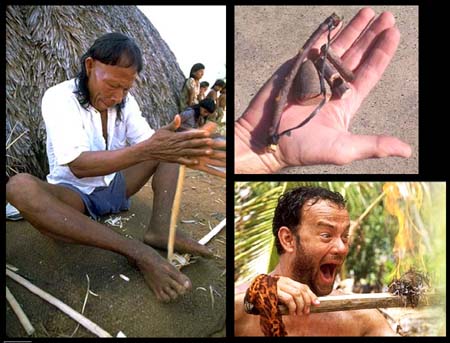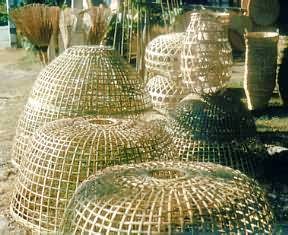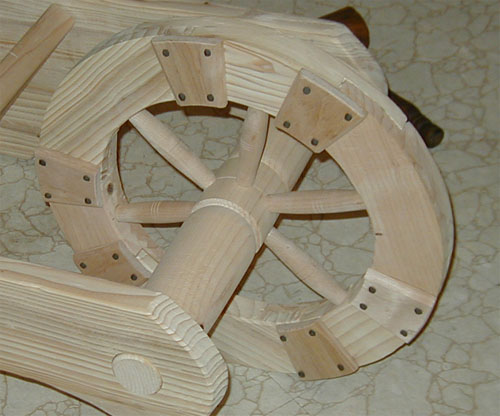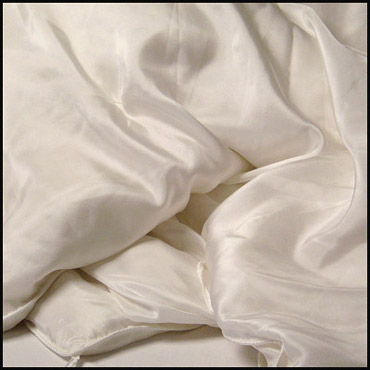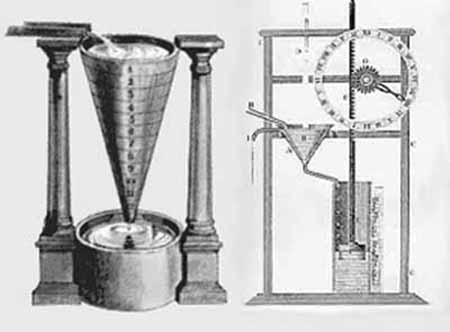The dawn of discovery
A long slow sequence of invention and discovery has made possible the familiar details of our everyday lives. Mankind's programme of improvements has been erratic and unpredictable. But good ideas are rarely forgotten. They are borrowed and copied and spread more widely, in an accelerating process which makes the luxuries of one age the necessities of the next.
The story is a disjointed one, since inventions and discoveries occur in a random fashion. They are described here in an approximately chronological sequence.
Two million years of stone technology represent the first long era of discovery at the start of human history. The use of fire, more than 500,000 years ago, is also a discovery. And some Stone Age artefacts (such as winged arrow-heads to stick in the flesh of the prey, or hooks carved in bone) have almost the quality of inventions. But these are developments of such an extended nature that they seem different in kind from the discoveries and inventions of more recent history.
Perhaps the first two ideas worthy of the name of 'invention', even though invented many times in many different places, are the eye of a needle and the string of a bow.
Needle and thread: from 15,000 years ago
In districts where warm clothing is necessary, Stone Age people stitch skins together with threads of tendon or leather thongs. For each stitch they bore a hole and then hook the thread through it.
The development of a bone or ivory needle, with an eye, speeds up the process immeasurably. The hole is now created by the same implement which then pulls the thread through, in an almost continuous movement. Needles of this kind have been found in caves in Europe from the late palaeolithic period, about 15,000 years ago. Several are so thin as to imply the use of materials such as horsehair for the thread.
The bow and arrow: from 15,000 years ago
The sudden release of stored energy, when a forcibly bent strip of wood is allowed to snap back into its natural shape, is more rapid and therefore more powerful than any impulse of which human muscles are capable - yet human muscles, at a slower rate, have the strength to bend the strip of wood.
The principle of the bow is discovered about 15,000 years ago. Bows and arrows feature from that time, no doubt both in hunting and warfare, in the regions of north Africa and southern Europe. The wood is usually ewe or elm. Stone Age technology is capable of producing sharp flint points for the arrows, often with barbs to secure them in the victim's flesh.
Making fire: more than 10,000 years ago
At some unknown time, before the beginning of settled life in the Neolithic Revolution, humans learn how to make fire. No doubt the discovery happens at many different times in many different places over a very long period. The knowledge of how to create a spark, and to nurture it until it develops into a flame, is an intrinsic skill of human society.
Almost without exception Stone Age tribes, surviving into modern times, have evolved in isolation their own methods of making fire. It is likely that the same was true when all humanity lived in the Stone Age.
The most common way of making fire is by friction, using a fire drill. This consists of a stick of hard wood, pointed at one end, and a slab of softer wood with a hole in it. If the point is placed in the cavity and rapidly twirled (by rubbing between the palms, or by means of a bow string looped round and pulled back and forth), the softer wood begins to smoulder. Shreds of dry tinder, placed in the smouldering cavity, can be carefully blown into a flame.
Another more sophisticated technique involves flint and pyrite. Evidence of both methods is found in neolithic tombs.
The useful quality of the naturally occurring mineral pyrite, or iron pyrites, is that it makes a spark if struck with a flint. If the spark is aimed into dry tinder, blowing can achieve a flame.
With the introduction of iron, it is discovered that the same principle applies between flint and steel. This eventually becomes the standard method of making fire. The European tinderbox of the 16th century is a portable fire-making kit, consisting of flint, steel, tinder to catch the spark and a match (like the wick of a lamp) to hold the fire in a steady and lasting glow. Not until the 19th century is this equipment replaced by matches in the modern sense.
However ingenious such methods of creating spark and flame, the process is laborious and in certain weather conditions impossible. Conserving fire, rather than making it, remains until modern times the practical approach to this most useful and dangerous of mankind's allies.
This important priority of domestic life is reflected in Rome's Vestal virgins, priestesses of great prestige and sanctity whose only ritual task is tending a flame.
Felt rugs and rush matting: 25,000 to 6000 years ago
Whether living in caves or temporary shelters, hunter-gatherers of the distant past make the ground more pleasant by strewing it with rushes or similar material. The first rugs, of a kind which can be lifted and used elsewhere, are probably of felt, made from the bark of trees. Felt rugs of this kind may have been used in the late Palaeolithic period, about 25,000 years ago.
The development of weaving, in the form of basketry, allows for the plaiting of rushes as a floor covering. This too may well begin in Palaeolithic times. But the first archaeological traces of plaited rushes on the floor date from no earlier than about 4000 BC, in Mesopotamia.
Felt garments: from 8000 BC
It is arguable that the invention of textiles is the single most liberating step in human history. Previously people have had a choice only of going naked in warm regions or wearing rough and clumsy furs in colder climates. The most elementary of fabrics - felt - is probably the first to be developed for garments.
Felt is a fabric in which fibres of any kind are made to intermesh not by spinning and weaving, but by processes of heat, damp and pressure. Wool, hair and fur are the conventional ingredients of felt. It can also be made from strips of bark, to produce floor coverings of the kind which Palaeolithic man may have used.
Woollen felt is probably in use for garments at least 10,000 years ago, well before the first weaving of textiles. But felt has little lasting strength. Its fibres pull gradually apart.
For a fabric with greater resilience, a woven material is required. The yarn for this can be acquired from the wool of sheep or goat, from the fluff surrounding the seeds of cotton, from the fibre in the stems of flax, or from the thin threads excreted by the silk worm. Any of these substances can be twisted by hand to form a strong thread. But greater efficiency requires the spindle.
The crafts of settled life: from 8000 BC
With the beginning of the Neolithic Revolution, about 10,000 years ago, several of mankind's basic crafts emerge over a relatively short span of time.
Sun-dried bricks make possible the beginning of architecture. In textiles, the spindle evolves to transform the spinning of thread. Weaving is perhaps first practised in the making of baskets, but soon the loom is developed for weaving cloth. Pottery provides greatly improved facilities for the storing and cooking of food.
Bricks: from 8000 BC
An innovation in the neolithic period is the use of bricks. In their simplest form (still familiar today in many hot regions), bricks are shaped by pressing mud or clay into a mould. The damp blocks are then left to bake hard in the sun. Bricks of this kind are known in Jericho from about 8000 BC.
The more durable type of brick, baked in a kiln, is an offshoot of the potter's technology. Kiln bricks are widely used in the two earliest civilizations, in Mesopotamia and Egypt, often to provide the outer surface of walls on an inner core of sun-dried brick.
Spinning: from 8000 BC
The spindle develops naturally from the process of twisting fibres into a thread by hand. The spun thread must be stored, and the easiest way is to wind it onto a stick. This means that the stick is also attached to the unfinished thread (the fibres which are still being twisted). The stick must therefore twist with the fibres.
Instead of being an encumbrance, this can be turned to advantage. If the stick is given greater weight, by attaching to it a lump of clay or a stone, its momentum will help in spinning the thread.
The thread can be turned into fabric in either of two ways. One of them links a continuous length of thread in rows of interconnected loops. This is knitting, which can create garments of any shape.
The other method, going back to at least 5800 BC, uses the thread in a rectangular criss-cross pattern to produce flat cloth. The vertical threads are stretched taut to form a grille; the horizontal threads are then interwoven between them. This is the process for all textiles of cotton, linen, silk or wool. It also produces tapestry. It makes the cloth which is decorated in embroidery. When loops are inserted, it gives the soft pile of rugs and carpets. All these involve the basic craft of weaving.
So the spindle acquires its two characteristics. It is a bobbin, on to which the spun thread is wound; and it is a flywheel, prolonging the spinning motion which creates the thread.
The spinner uses one hand to draw out the fibres from the bundle of wool, cotton or flax, thus extending the half-spun thread to which the spindle is attached. The other hand gives a rotating flick to the spindle whenever it begins to lose impetus. Hand-spinning of this sort becomes a basic cottage industry throughout the world.
Basketry: from 7000 BC
The development of basketry can be seen also as the first step towards weaving. The interweaving of strands of reed or osier, to make a simple container, is an elementary process which rapidly provides an extremely useful object.
The impermanence of the materials means that the earliest surviving fragments of baskets (from a cave in Utah) date only from about 7000 BC, but the craft is almost certainly practised considerably earlier. From around 5800 BC we have scraps of woven textiles, preserved because carbonized in the fire which destroys one of the levels of Catal Huyuk.
Loom: from 6000 BC
Weaving of cloth requires a loom - a structure which will hold taut the vertical threads (the warp), while the weaver snakes each horizontal thread in and out to form the weft. When the threads of the weft are pressed down tight, to form a solid mesh with the warp, a section of the cloth at the bottom of the loom is complete. A pattern is achieved by varying the colour of the threads in warp and weft.
The earliest known evidence of a loom comes from Egypt in about 4400 BC, but some method of supporting the warp exists from the beginning of weaving. The threads must either be suspended (and held taut by a weight at the bottom) or else must be stretched in the rigid frame of a conventional loom.
weaving: from 6000 BC
Until recently the earliest known scraps of cloth are woven from wool; dating from about 5800 BC, they come from Catal Huyuk in Anatolia. Similarly the first known example of linen has been from about 5000 BC in Egypt, where flax (an indigenous wild plant in the Mediterranean region) is cultivated. But a small woven fragment discovered in 1993 near the upper reaches of the Tigris probably pushes back the available evidence. It appears to be linen and has been dated to about 7000 BC.
Cotton is grown in both Eurasia and America; woven cotton survives from about 2500 BC in the Indus valley and slightly later in Peru. The most precisely localized source of any major fabric is China, where pieces of woven silk are known from about 2850 BC.
Pottery: from 6500 BC
One of the most useful of all human discoveries is pottery. Indeed a standard distinction made by archaeologists, when describing successive cultures in an area, is between groups which are 'aceramic' (without pottery) and others which have mastered the technology of clay and kiln.
In western Asia, where the Neolithic Revolution is most advanced, the first pottery at sites such as Catal Huyuk dates from about 6500 BC.
The earliest wares at Catal Huyuk are made by one of the standard methods of primitive potters. Rings or coils of clay are built up from a circular base. The walls of the pot are then smoothed and thinned (by simultaneous pressure on the inner and outer surfaces) before being fired in a bread oven or in the most elementary of kilns - a hole in the ground, above which a bonfire is lit.
Early neolithic pottery is usually undecorated. Where there is decoration, it takes the form of patterns cut or pressed into the damp clay.
Alcohol: from the 4th millennium BC
Humans must frequently have discovered, in a series of happy accidents, the pleasant side-effects of drinking the fermented juice of grape or grain. The earliest evidence of the systematic production of alcohol comes from Mesopotamia, where by the 4th millennium BC beer is brewed on a regular basis. Barley is indigenous in the region.
Beer subsequently becomes the national drink of ancient Egypt. From there the secrets of brewing spread round the Mediterranean. A standard way of achieving the necessary mix of barley and yeast is to allow mashed barley bread to ferment. So brewing becomes, in these early times, part of the baker's trade.
The potter's wheel: 3000 BC
When a pot is built up from the base by hand, it is impossible that it should be perfectly round. The solution to this problem ia the potter's wheel, which has been a crucial factor in the history of ceramics. It is not known when or where the potter's wheel is introduced. Indeed it is likely that it develops very gradually, from a platform on which the potter turns the pot before shaping another side (thus avoiding having to walk around it).
By about 3000 BC a simple revolving wheel is a part of the potter's equipment in Mesopotamia, the cradle of so many innovations.
The wheel: 3000 BC
The wheel is often quoted as the single most important advance in early technology. It is sometimes said to have evolved from the potter's wheel. Both are first known at approximately the same period, around 3000 BC. But they share no geographical origin and it is intrinsically unlikely that either form would suggest the other. Each is a natural solution to a very different problem.
In early technology a wagon wheel can only be made from wood. Several of the earliest known wheels have been found in the heavily forested regions of Europe.
The Egyptian papyrus: 3000 BC
The discovery of an easily portable substance to write on is almost as old as writing itself. Around 3000 BC, in Egypt, people begin making a flexible smooth surface, which will accept and retain ink without blur or smudge.
It is known by the name of the aquatic plant which provides the structure - papyrus. It will remain in regular use longer than any other material in the history of written documents.
The plough and draught animals: from 3000 BC
The plough is almost certainly the first implement for which humans use a source of power than their own muscles.
When planting seeds, it is essential to break up the ground. In the early stages of agriculture this is achieved by hacking and scraping with a suitably pointed implement - the antler of a deer, or a hooked and pointed branch of a tree. But a useful furrow can more easily be achieved by dragging a point along the surface of the ground. The first ploughs consist of a sharp point of timber, sometimes hardened in a flame or tipped with flint, projecting downwards at the end of a long handle.
In the light soil of Egypt and Mesopotamia, where ploughing is first undertaken, a simple pointed implement of this kind is sufficient to break up the earth and form a shallow trench. Such a plough can be dragged by a couple of men. But the use of draught animals, from at least 3000 BC, greatly speeds up the process.
In northern Europe, with heavier soil, this type of plough is ineffective. A more elaborate machine is developed, probably by the Celts in the 1st century BC, in which a sharb blade cuts into the earth and an angled board turns it over to form a furrow.
silk: 2850 BC
People in China find a use for the cocoons spun by the caterpillars of certain moths. If moistened, the thread of a cocoon can be carefully unwound. Twisted with the thread of other cocoons, it will make a filament strong enough for weaving. The result is silk.
The earliest known silk consists of some threads and woven fragments assigned by carbon-dating to about 2850 BC. The thread of the earliest examples is from wild silk moths, indigenous to China. But soon one species of the moth, bombyx mori, is domesticated. The manufacture of silk becomes one of the most jealously guarded secrets of early Chinese civilization.
Glass: c.1500 BC
In Phoenicia, in about 1500 BC, the making of glass becomes a practical craft. Glass beads are known in Egypt 1000 years earlier, but they are probably shaped from glass which has been formed accidentally where the necessary materials and heat coincide.
The Phoenicians discover how to make glass on a predictable basis (from sand, limestone and sodium carbonate) and they invent ways of shaping this difficult but magically appealing substance into small vessels. The basic method, known as core-forming, consists of applying the molten glass to the outside of a solid core of soft clay. When the glass has cooled and hardened, the core can be scraped out.
These Phoenician skills are carried south to Egypt during the 15th century BC, after the shores of the eastern Mediterranean are conquered by the Egyptian pharaoh Thutmose. Small bottles, to hold precious oils for cosmetic purposes, become treasured items in rich
Egyptian households. The body of the vessel is usually a transparent blue, sometimes decorated with thread-like rings of white, yellow or green applied to the surface.
Glass is an expensive rarity, and remains so in Egypt and elsewhere (Mesopotamia, Greece, Persia) until Roman times. The change to a more widely available household material results from another breakthrough in glass technology - again in Phoenicia, now transformed into Roman Syria.
sundial and water clock: from the 2nd millennium BC
The movement of the sun through the sky makes possible a simple estimate of time, from the length and position of a shadow cast by a vertical stick. (It also makes possible more elaborate calculations, as in the attempt of Erathosthenes to measure the world - see Erathosthenes and the camels). If marks are made where the sun's shadow falls, the time of day can be recorded in a consistent manner.
The result is the sundial. An Egyptian example survives from about 800 BC, but the principle is certainly familiar to astronomers very much earlier. However it is difficult to measure time precisely on a sundial, because the sun's path throug the sky changes with the seasons. Early attempts at precision in time-keeping rely on a different principle.
The water clock, known from a Greek word as the clepsydra, attempts to measure time by the amount of water which drips from a tank. This would be a reliable form of clock if the flow of water could be perfectly controlled. In practice it cannot. The clepsydra has an honourable history from perhaps 1400 BC in Egypt, through Greece and Rome and the Arab civlizations and China, and even up to the 16th century in Europe. But it is more of a toy than a timepiece.
The hourglass, using sand on the same principle, has an even longer career. It is a standard feature on 18th-century pulpits in Britain, ensuring a sermon of sufficient length. In a reduced form it can still be found timing an egg.
Navigation by Polaris: from c.1100 BC
The use of Polaris, the pole star, as a navigational aid is credited to the Phoenicians (the position of the pole star in the sky is so close to the northern end of the axis on which the earth rotates that it appears static throughout each night and is a reliable indication of due north). The Phoenicians also build up a store of information about winds and currents, which they guard jealously as valuable trade secrets.
One extraordinary indication of their skills is an expedition of about 600 BC. Sponsored by an Egyptian pharaoh, Phoenician ships make a complete voyage round the coast of Africa (see the First sea voyage round Africa).
Glazed ceramics: 9th - 1st century BC
In all the early civilizations, from Mesopotamia and Egypt onwards, pottery is a highly developed craft. An outstanding achievement is the Greek ceramic tradition of the 6th and 5th century BC. But technically all these pots suffer from a major disadvantage. Fired earthenware is tough but it is porous. Liquid will soak into it and eventually leak through it. This has some advantages with water (where evaporation from the surface cools the contents of the jug) but is less appropriate for storing wine or milk.
The solution is the addition of a glaze. This technological breakthrough is made in Mesopotamia in the 9th century BC for decorative tiles. It is not adapted for practical everyday purposes until many centuries later.
A glaze is a substance, applied to the inner or outer surface of an unfired pot, which vitrifies in the kiln - meaning that it forms a glassy skin, which fuses with the earthenware and makes it impermeable to liquids.
But glazes, which can be of any colour, also have a highly decorative quality. It is for this purpose that they are first developed, as a facing for ceramic tiles, in Mesopotamia from the 9th century BC. The most famous examples are from the 6th century palace of Nebuchadnezzar in Babylon.
Glazed pots make their appearance in the Middle East in about the 1st century BC, possibly being developed first in Egypt. The characteristic colour is green, from copper in the glaze. Pottery of this kind is common in imperial Rome a century later.
By this time glazed pottery is also being manufactured in Han dynasty China. It may be that the development occurs independently in the Middle East and in China, but by now there could also be a direct influence in either direction. Rome and China are already linked by the Silk Road, and glazed ceramics are attractive commodities.
Lock and key: c.710 BC
In Assyria, at Khorsabad, an expensive wooden bolt is installed in the new palace of Sargon II. It is the world's earliest surviving lock.
Within the bolt are several holes. When the bolt is pushed home, wooden pins fall down into these holes from within the frame of the door, holding the bolt fast. The only way of releasing it is to insert a key, shaped like a tooth brush, into a hollow cavity in the bolt below the pin holes. The key has projecting pins in the necessary pattern. When pressed upwards they will raise the other pins, allowing the bolt to be withdrawn.
Persian carpets: 6th century BC
Persian emperors of the 6th century BC are among the first to make a display of lavish floor coverings. Carpets becomes one of the characteristic art forms of people living on the high plateau of west Asia, from Turkey through Iran, where winters can be extremely cold.
They are a particularly important form of wealth and comfort for the nomadic tribes which live in these regions and in the steppes to the north. One of the earliest true carpets to survive (woven with a knotted pile, and Persian in origin) belongs to a tribal ruler in about 500 BC. It is discovered in his frozen tomb at Pazyryk.
lacquer: c.500 BC
The Chinese discover that the sap of a tree, Rhus vernicifera, has unusual qualities. It can be applied in successive layers to wooden objects, such as dishes and boxes, and each layer can be hardened by exposure to moisture.
The resulting surface, so hard that it is not corroded by acid, can be brought to a very smooth polish, or decorated with gold and silver dust, or delicately carved to reveal the successive layers beneath. This technique of lacquer, adopted also in Japan by the 6th century AD, provides one of the most highly valued commodities of the orient.
Electricity and magnetism: 5th century BC
Two natural phenomena, central to the study of physics, are observed and speculated upon by Greek natural scientists - probably in the 5th century BC, though Aristotle gives credit for the first observation of each to the shadowy figure of Thales.
One such phenomenon is the strange property of amber. If rubbed with fur it will attract feathers or bits of straw. Modern science, in its terms for the forces involved, acknowledges this Greek experiment with amber (electron in Greek). The behaviour of the amber is caused by what we call electricity, resulting from the transfer of what are now known as electrons.
The other natural phenomenon also derives its scientific name from Greek experiments. It is lodestone, a naturally occurring mineral (formed of iron oxide), which will surprisingly attract small pieces of iron.
The Greeks find this mineral in a region of Thessaly called Magnesia. They call it lithos magnetis, the 'stone of Magnesia'. Thus the magnet is identified and named, though like rubbed amber it will only be a source of interest and amusement for the next 1000 years and more - until a practical purpose is found for it in the form of the compass.
Distillation: 4th century BC
The principle of distillation is probably in use long before it is applied to the production of alcohol. Greek sailors of the 4th century BC know how to derive fresh water from the sea, by boiling salt water and suspending a sponge in the steam (pure water condenses in the sponge).
The distillation of alcohol is possible because it boils at a lower temperature than water. In the simplest form of still, the alcohol vapour condenses on a cold surface held in the steam. Subsequent improvements, achieved at various places and different times, involve channelling the steam into a separate condenser and cooling it in such a way as to separate any intrusive water vapour from the alcohol.
Pulley: 4th century BC
An important adaptation of the wheel in technology is the pulley - a wheel round which a rope is run to exert force on an object at the other end. Such a machine is first mentioned in a Greek text of the 4th century BC, but it is likely to have been known much earlier.
In the simplest pulley a single wheel is used (as in hauling a flag up a flagpole), but major mechanical advantages can be achieved with two or more wheels - making it possible to lift a heavier object, albeit more slowly. The effect of two pulleys is that a force capable of pulling the rope two yards at one end will exert twice that force over a distance of only one yard at the other. The effect increases dramatically with more pulleys.




